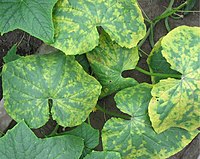
Photo from wikipedia
Tomato mottle mosaic virus, a new species in the genus Tobamovirus and family Virgaviridae, was first reported on tomato in Mexico in 2013 (Li et al. 2013). Subsequently, tomato mottle… Click to show full abstract
Tomato mottle mosaic virus, a new species in the genus Tobamovirus and family Virgaviridae, was first reported on tomato in Mexico in 2013 (Li et al. 2013). Subsequently, tomato mottle mosaic virus (ToMMV) was found infecting pepper and eggplant in China (Li et al. 2014; Chai et al. 2018). ToMMV was thought to pose a serious risk to solanaceous crops due to its potential to break resistance and numerous transmission ways (Li et al. 2020), meanwhile, some plant species in the families of Amaranthaceae, Brassicaceae, Cucurbitaceae, and Verbenaceae, were found as the hosts of ToMMV under experimental condition (Sui et al. 2017; Li et al. 2020). To clarify the occurrence of ToMMV in Yunnan province of China, 395 plant samples, including tomato (Solanum lycopersicum L.), pepper (Capsicum annuum L.) and pea (Pisum sativum L.), exhibiting viral-like symptoms were collected in major crop plantations in Yunnan province in 2020. Total nucleic acids were extracted from the diseased samples using a CTAB method (Li et al. 2008), and tested by reverse transcription polymerase chain reaction (RT-PCR) with ToMMV specific primers, ToMMVMPF (5'-ATGGCTCTAACTGTTAGTGGT-3') and ToMMVMPR (5'-TTAATACGAATCAGATCCCGCG-3'), which were designed based on the movement protein gene sequence of ToMMV YYMLJ isolate (KR824950). ToMMV was detected in 13 symptomatic samples (11 cherry tomato and 2 green pea plants) with a total detection rate of 3.29%. An 807-bp fragment was amplified from 2 out of 86 pea samples showing foliar chlorosis, mosaic, malformation and necrosis symptoms, and the amplicons were cloned and sequenced. Sequences obtained from the two pea samples were identical. Therefore, one sequence was deposited in the GenBank (accession no. MW561348). BLAST search result showed that the nucleotide sequence had the highest identity of 99.88% with the ToMMV TiLhaLJ isolate (KR824951). The ToMMV infection on the two pea samples was also verified by dot-enzyme immunoassay (Dot-ELISA) using ToMMV monoclonal antibody (kindly provided by Dr. Jianxiang Wu, Zhejiang University, China). To determine the pathogenicity of ToMMV on pea, ToMMV infectious cDNA clone was used to inoculate into 3-week-old healthy pea plants via an Agrobacterium-mediated method (Tu et al. 2021). Mottle or slight mosaic, chlorosis and malformation symptoms were observed on the upper leaves of the 8 out of 12 inoculated plants 8 days postinoculation, and ToMMV could be detected by RT-PCR from the 8 symptomatic plants but not from the asymptomatic and healthy control pea plants with the above described ToMMV specific primer pair. ToMMV has now only been detected in Mexico, China, Spain, USA, Israel and Australia on tomato, pepper and eggplant (Webster et al. 2014; Turina et al. 2016; Ambrós et al. 2017; Lovelock et al. 2020). To the best of our knowledge, this is the first report of natural infection of ToMMV in pea as well as the natural infection of ToMMV on plants outside of the family Solanaceae. The result also implies that ToMMV has a potential risk to more crops in the field. Since pea, pepper and tomato are economically important cash crops in China, proper virus management strategies for the cultivation of these crops should be adopted.
Journal Title: Plant disease
Year Published: 2021
Link to full text (if available)
Share on Social Media: Sign Up to like & get
recommendations!